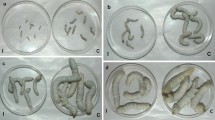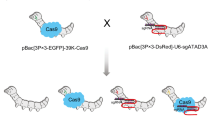Abstract
Infections due to Bombyx mori nucleopolyhedro virus (BmNPV) in commercially important silkworm, Bombyx mori L. (Lepidoptera: Bombycidae) causes up to 50% loss to silk production in India. Increased resistance to NPV through introduction of double stranded RNA transgenes against multiple NPV genes is reported in B. mori. However, stability of the RNAi - mediated antiviral activity has not been determined after several generations of inbred transgenic B. mori. Hence, we examined the NPV multiplication rate and induction of the disease symptoms in NPV- infected transgenic and non-transgenic silkworm after 35 generations. Significantly higher multiplication rate of NPV supported by higher copy number of gp-41 gene was observed in non- transgenic larvae as compared to transgenic larvae. Expression of NPV genes, ie-1, lef1 and p74 enhanced significantly in non-transgenic larva as compared to transgenic larva after NPV infection. Strong positive correlation was observed in the expression pattern of NPV genes in transgenic larvae which was absent in non-transgenic larvae. This indicated co-regulation of NPV gene expression in the presence of transgenes.





Similar content being viewed by others
References
Anitha J, Pradeep AR, Awasthi AK, Murthy GN, Ponnuvel KM, Sasibhushan S, Rao CGP (2013) Coregulation of host–response genes in integument: switchover of gene expression correlation pattern and impaired immune responses induced by dipteran parasite infection in the silkworm, Bombyx mori. J Appl Genet 55:209–221. https://doi.org/10.1007/s13353-013-0183-8
Bao Y-Y, Tang X-D, Lv Z-Y, Wang X-Y, Tian C-H, Xu YP, Zhang C-X (2009) Gene expression profiling of resistant and susceptible Bombyx mori strains reveals nucleopolyhedrovirus-associated variations in host gene transcript levels. Genomics 94:138–145. https://doi.org/10.1016/j.ygeno.2009.04.003
Basavaraja HK, Raju PJ, Basha KI, Satyavathi VV (2016) Conservation status and maintenance of baculovirus resistant transgenic silkworm, Bombyx mori L. in India. In: Silk for the green world and sustainable development (24th ISC Congress, Bangok, Thailand). International Sericultural Commission, Bangalore
Berretta MF, Ferrelli ML, Salvador R, Sciocco A, Romanowski V (2013) Current issues in molecular virology - Viral Genetics and biotechnological applications. In: Romanowski V (ed) Baculovirus Gene Expression; InTech, Croatia. https://www.intechopen.com/books/current-issues-in-molecular-virology-viral-genetics-and-biotechnological-applications
Bryant JA, Sellars LE, Busby SJW, Lee DJ (2014) Chromosome position effects on gene expression in Escherichia coli K-12. Nucleic Acids Res 42:11383–11392. https://doi.org/10.1093/nar/gku828
Carson D, Summers M, Guarino C (1991) Molecular analysis of a baculovirus regulatory gene. Virology 182:279–286
Cory JS, Franklin MT (2012) Evolution and the microbial control of insects. Evol Appl 5:455–469
Cory JS, Myers JH (2003) The ecology and evolution of insect baculoviruses. Annu Rev Ecol Evol Syst 34:239–272. https://doi.org/10.1146/annurev.ecolsys.34.011802.132402
Davidson BL, McCray PB Jr (2011) Current prospects for RNA interference-based therapies. Nat Rev Genet 12:329–340
Evans JT, Leisy DJ, Rohrmann GF (1997) Characterization of the interaction between the baculovirus replication factors LEF-1 and LEF-2. J Virol 71:3114–3119
Faulkner P, Kuzio J, Williams GV, Wilson JA (1997) Analysis of p74, a PDV envelope protein of Autographa californica nucleopolyhedro virus required for occlusion body infectivity in vivo. J Gen Virol 78:3091–3100
Gerardo NM, Altincicek B, Anselme C, Atamian H, Barribeau SM, de Vos M, Duncan EJ, Evans JD, Gabaldon T, Ghanim M, Heddi A, Kaloshian I, Latorre A, Moya A, Nakabachi A, Parker BJ, Pérez-Brocal V, Pignatelli M, Rahbe Y, Ramsey JS, Spragg CJ, Tamames J, Tamarit D, Tamborindeguy C, Vincent-Monegat C, Vilcinskas A (2010) Immunity and other defenses in pea aphids, Acyrthosiphon pisum. Genome Biol 11:R21. https://doi.org/10.1186/gb-2010-11-2-r21
Isobe R, Kojima K, Matsuyama T, Quan GX, Kanda T et al (2004) Use of RNAi technology to confer enhanced resistance to BmNPV on transgenic silkworms. Arch Virol 149:1931–1940
Jiang L, Xia Q (2014) The progress and future of enhancing antiviral capacity by transgenic technology in the silkworm Bombyx mori. Insect Biochem Molec Biol 48:1–7
Kanginakudru S, Royer C, Edupalli SV, Jalabert A, Mauchamp B et al (2007) Targeting ie-1 gene by RNAi induces baculoviral resistance in lepidopteran cell lines and in transgenic silkworms. Insect Mol Biol 16:635–644
Kool M, Ahrens CH, Goldbach RW, Rohrmann GF, Vlak JM (1994) Identification of genes involved in DNA replication of the Autographa californica baculovirus. Proc Natl Acad Sci U S A 91:11212–11216
Kuzio J, Jaques R, Faulkner P (1989) Identification of p74, a gene essential for virulence of baculovirus occlusion bodies. Virology 173:759–763
Lehane MJ, Blakemore D, Williams S, Moffatt MR (1995) Regulation of digestive enzyme levels in insects. Comp Biochem Physiol Part B: Biochem Mol Biol 110B:285–289
Li Y, Passarelli AL, Miller LK (1993) Identification, sequence, and transcriptional mapping of lef-3, a baculovirus gene involved in late and very late gene expression. J Virol 67:5260–5268
Livak KJ, Schmittagen TD (2001) Analysis of relative gene expression data using real time quantitative PCR and the 2–∆∆ CT method. Methods 25:402–408
Mansson R, Tsapogas P, Akerlund M, Lagergren A, Gisler R, Sigvardsson M (2004) Pearson correlation analysis of microarray data allows for the identification of genetic targets for early B-cell factor. J Biol Chem 279:17905–17913
Mueller S, Gausson V, Vodovar N, Deddouche S, Troxler L et al (2010) RNAi-mediated immunity provides strong protection against the negative-strand RNA vesicular stomatitis virus in Drosophila. Proc Natl Acad Sci U S A 107:19390–19395
Naylor MG, Lin X, Weiss ST, Raby BA, Lange C (2010) Using canonical correlation analysis to discover genetic regulatory variants. PLoS One 5(5):e10395. https://doi.org/10.1371/journal.pone.0010395
Nissen MS, Friesen PD (1989) Molecular analysis of the transcriptional regulatory region of an early baculovirus gene. J Virol 63:493–503
Pradeep AR, Anitha J, Awasthi AK, Babu MA, Geetha MN, Arun KH, Chandrashekhar S, Rao GC, Vijayaprakash NB (2012) Activation of autophagic programmed cell death and innate immune gene expression reveals immuno-competence of integumental epithelium in Bombyx mori infected by a dipteran parasitoid. Cell Tissue Res 352:371–385. https://doi.org/10.1007/s00441-012-1520-7. Epub 2012 Nov 18
Prikhod’ko EA, Miller LK (1996) Induction of apoptosis by baculovirus transactivator IE1. J Virol 10:7116–7124
Rahman MM, Gopinathan KP (2004) Systemic and in vitro infection process of Bombyx mori nucleopolyhedro virus. Virus Res 101:109–118
Reynier F, Petit F, Paye M, Turrel-Davin F, Imbert P-E, Hot A, Mougin B, Miossec P (2011) Importance of correlation between gene expression levels: application to the type I interferon signature in rheumatoid arthritis. PLoS One 6:e24828. https://doi.org/10.1371/journal.pone.0024828
Rockman MV, Skrovanek SS, Kruglyak L (2010) Selection at linked sites shapes heritable phenotypic variation in C. elegans. Science 330:372–376. https://doi.org/10.1126/science.1194208
Subbaiah EV, Royer C, Kanginakudru SK, Satyavati VV et al Couble P, Nagaraju J (2013) Engineering silkworms for resistance to baculovirus through multigene RNA interference. Genetics 193:63–75. https://doi.org/10.1534/genetics.112.144402
Sugimori H, Nagamine T, Kobayashi M (1990) Analysis of structural polypeptides of Bombyx mori (Lepidoptera: Bombycidae) nuclear polyhedrosis virus. Appl Entomol Zool 25:67–77
Tanaka H, Ishibashi J, Fujita K, Nakajima Y, Sagisaka A, Tomimoto K, Suzuki N et al, Yamakawa K (2008) A genome-wide analysis of genes and gene families involved in innate immunity of Bombyx mori. Insect Biochem Molec Biol 38:1087–1110
Terenius O, Papanicolaou A, Garbutt JS, Eleftherianos I, Huvenne H, Kanginakudru S et al (2010) RNA interference in Lepidoptera: an overview of successful and unsuccessful studies and implications for experimental design. J Insect Physiol 57:231–245. https://doi.org/10.1016/j.jinsphys.2010.11.006
Varada B, Pradeep AR, Awasthi AK, Sivaprasad V, Ponnuvel KM, Mishra RK (2017) Non-target host immune gene modulation in transgenic silkworm Bombyx mori endowed with RNAi silence BmNPV Genes. Biotechnol J Int. 20(4): 1–12, 2017; Article no. BJI.39442
Xu J, Wang X-F, Chen P, Liu F-T, Zheng S-C, Ye H, Mo M-E (2016) RNA Interference in Moths: Mechanisms, Applications, and Progress. Genes (Basel) 7:88. https://doi.org/10.3390/genes7100088
Zhang P, Wang J, Lu Y, Hu Y, Xue R, Cao G, Gong C (2014) Resistance of transgenic silkworm to BmNPV could be improved by silencing ie-1 and lef-1 genes. Gene Ther 21:81–88
Acknowledgements
The authors express sincere thanks to the anonymous reviewers for critical reading and Central Silk Board, Bangalore for facilities and approval.
Funding
This work was supported by Department of Biotechnology (DBT), Government of India, New Delhi in the form of a research project on transgenic silkworm under Center of Excellence program (BT/01/COE/15/12-II dated 28/09/2011) to Center for DNA Fingerprinting & Diagnostics, Hyderabad and partially to Seribiotech Research Laboratory, Bangalore (AKA). VB is supported by research fellowship from the project.
Author information
Authors and Affiliations
Corresponding author
Ethics declarations
Conflict of interest
Authors declare that they have no conflict of interest.
Electronic supplementary material
Supplementary Fig. 1
Genomic DNA of BmNPV purified from the NPV-infected B. mori larva was amplified using primers of the NPV genes ie-1, lef-1, lef-3, p-74 and gp-41 confirming NPV infection in early stage. Product size of the amplicons (in base pairs) is given in brackets. M- DNA ladder- Mass Ruler, Thermo). (PNG 3675 kb)
Rights and permissions
About this article
Cite this article
Varada, B., Pradeep, A.N.R., Awasthi, A.K. et al. Modulation of NPV gene expression pattern and retention of RNAi- based antiviral activity in inbred transgenic silkworm. Int J Trop Insect Sci 40, 483–491 (2020). https://doi.org/10.1007/s42690-020-00201-z
Accepted:
Published:
Issue Date:
DOI: https://doi.org/10.1007/s42690-020-00201-z




